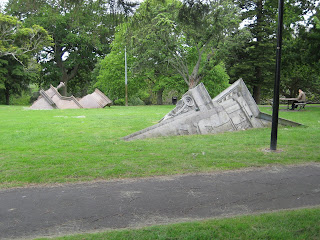Tonight at 4pm in City Hall downtown, a public meeting was held to solicit citizens' opinions on a request being developed by the city on how to spend $2.7 million in federal funding to combat the foreclosure problem.
part onefirst, a side note and some history:
In the Housing and Economic Recovery Act passed in July 2008 by Congress, $258 million was allocated to Ohio to help with the housing crisis. The first round of funding from this Act distributed $116 to the state, and Youngstown got $2.7 million.
This was a welcomed, yet disappointing amount to many folks, as cities with smaller populations and smaller foreclosure rates received more money than Youngstown.
For example, Columbus with a foreclosure rate of 6.9% albeit a larger population, received $22 million.
Canton, with a smaller foreclosure rate of 12.3% and a smaller population than the Yo, received $3.6 million.
But to re-center the discussion - Youngstown's foreclosure rate of 14.7%, the highest of any city in Ohio, received $2.7 million.
More on this imbalance to come.
The issue now at hand is how to spend the $2.7 million.
part twosome maps to observe.
The first is of the houses slated for demolition in the city of Youngstown:

The second is of the 1,044 houses foreclosed by banks in all of 2007 to July 2008:

Some quick
stats:
- the median housing value in the city of Youngstown is $40,900
- 54.6% of the mortgage loans from 04-06 in the city were subprime
- 22.6% of mortgages in the state of Ohio in that time were subprime
- the foreclosure rate in Youngstown is 14.7%
- the foreclosure rate in Ohio is 6.2%
- 351 structures were demolished by the city in 2006
- 474 structures were demolished by the city in 2007
part threeUsing these maps and this information, the
draft plan on how to spend the $2.7 million is now online. From November 6th through November 20th, comments will be accepted at:
NSPComments (at) cityofyoungstownoh (dot) com
These tracts in purple then, using the quidelines of the federal government, have been identified as targeted areas for the $2.7 million:

Interesting to note though by reading the draft plan, how components of the Youngstown 2010 Plan were used to assist these funding decisions. It's also important to recognize this draft plan is only for suggesting how a chuck of funds from the feds is spent for this unique and specific component. Purple does not identify "important" vs. "non-important" sections of the city.
But it is cool to see how planning tools and information can help to make strategic decisions.
part fourfinally, a timely opinion piece on a somewhat related topic.
note: I
am not trying to draw any conclusions about parts one to three vs. part four. This post is simply a way to aggregate information and 3rd party opinions.
A recent article
published by Charles Buki at the Planetizen blog on Oct. 30th titled "The Work of Neighborhood Stabilization" has been getting a lot of attention.
He contends the standard response to community development has been to put resources in (1) communities hurting the most, or (2) spreading a little bit of assistance everywhere.
Buki believes these are the
wrong approaches.
The question he states should not be
where is the area of greatest need, but
which area has the greatest chance of success?
Using that strategy, middle market neighborhoods still with signs of strength and assets that are marketable with minor improvements should be targeted first for assistance. These are the tipping point neighborhoods.
so simply put, what do you think of the Buki approach?
Should we:
target the tippers;
spread the resources;
or invest only where problems are worst?





































